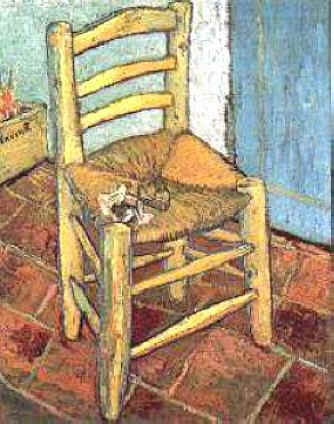Casey Arfsten - Vincent's Empty Chairs
| Art is a symbolic communication between people, which
attempts to communicate something beyond itself. Symbols are pure expressions
of truth used by artists to create an emotional reaction. Interpretation
of symbolic art reveals the hidden, unspoken message of an artist. What
is the unspoken message within Vincent van Gogh's paintings, Vincent's
Chair (1888) and Gauguin's Chair (1888). Vincent, an intelligent, articulate
man, suffered from extreme depression. His unstable mind enabled van Gogh
to create incredible symbolic art, but also led to his tragic suicide.
His "diverse works encompassed radical changes in style, color, and
subject matter, which was perhaps indicative of his varying states of
mind" (Hawksley). Before one can analyze
the symbolic nature of van Gogh's two chair paintings, it is necessary
to describe the relationship between Vincent and Paul Gauguin. For a period
of about eight weeks, "Dutch painter Vincent van Gogh and French
artist Paul Gauguin shared a tiny studio in the two-story home known by
art lovers as the Yellow House" (Hale).
This was a period of extreme creativity for van Gogh, who averaged one
painting a day in Gauguin's company. Unfortunately, the two artists shared
many creative differences, which inevitably led to many bitter arguments.
When separation seemed inevitable, van Gogh produced two pieces foreshadowing
his loneliness, Vincent's Chair and Gauguin's Chair. |
|
"Empty chairs had a very personal
significance for van Gogh, who appears to have associated objects strongly
with people" (Cutts and Smith).
Van Gogh personifies the chairs into representations of the men themselves.
Vincent's Chair is a daytime painting, with a golden wood chair reflecting
golden yellow sunlight. The angles are sharp and precise; the colors
are limited. The tone of this painting is somber with yellow, tan, and
orange highlights. The only change in color is a green door to the right
of the chair. Vincent chose a simple chair with simple colors to depict
himself. The emptiness of the painting is evident. A chair's purpose
is relaxation for a person. The painting, with an empty chair, leaves
its audience with an incomplete feeling. Upon this chair, is tobacco
(probably tobacco) and a pipe, personal items of van Gogh.
|
|
Gauguin's Chair is almost morbid in comparison to Vincent's Chair. The first difference between the two paintings is the obvious fact that van Gogh neglects to use Gauguin's first name in the title. He uses the more formal, last name, which indicates the separation between the two men. There are two light sources in this painting, a gas-light and a candle, indicating nighttime. The lights represent "twin sparks of inspiration," the two lights of van Gogh and Gauguin together (Cutts and Smith). The color scheme in this painting is bold and dark. The colors are richer and more saturated. The chair is a piece of art, carved with expensive wood. There are two books lying upon the chair "symbolizing what van Gogh believed to be the intellectual nature of Gauguin's endeavors" (Cutts and Smith). The floor is distorted and unrealistic. In Vincent's Chair the floor resembled simple tile or linoleum, but this in contrast is confusing and scary. Again, the emptiness of the chair reveals the emptiness in Vincent's heart. Van Gogh's temper was the primary reason for the separation of these two artists. His temper is apparent the construction of the two paintings. Vincent's Chair is soft and the paint is thin in most areas, whereas Gauguin's Chair is painted thick and dark. The brush strokes are jagged and poorly blended. This reflects Vincent's anger toward Gauguin. Van Gogh depicts their separation with a personification of two chairs. "Both chairs are alive, like strange creatures" (Cutts and Smith). Gauguin's Chair, however is the more menacing of the two. Van Gogh is making a statement about his relationship with Paul Gauguin. |
These two paintings are rich with symbolism.
The emptiness the van Gogh reflects is very effective with the painting of
two empty chairs.
There is also the symbolic indication of van Gogh's opinion of Gauguin at
this point.
Works Cited
Cutts, Josephine and James Smith. Essential
Van Gogh. Parragon Publishing, UK. 2000. With an introduction
by: Lucinda Hawksley.
Hale, Debra. "Museum Has Spent Years Preparing for Major
Van Gogh, Gauguin Exhibition," The Arizona Republic.
The Associated Press, June 20, 2001.

